Top News
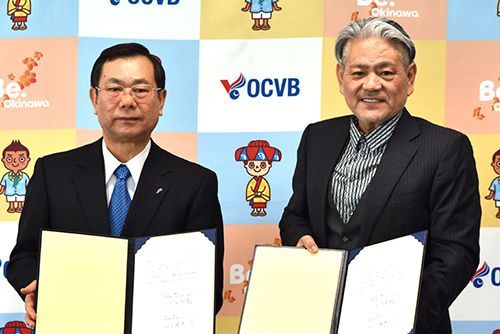
January 12, 2018 Ryukyu Shimpo
The Okinawa Marine Leisure Safety Bureau (OMSB) will institute its system to certify the excellence of diving companies and guides on April 1. On January 11, OMSB signed a comprehensive business alliance with the Okinawa Tourism Convention Bureau (OCVB) to launch the system. The OCVB will list certified companies on its homepage with the aim of building a safe and trusted Marine Leisure brand.
According to OMSB, systems to certify diving ability are rare in Japan.
There are more than 900 diving companies in Okinawa, which has created price competition. Because the majority are individual businesses, opportunities for continued education in the latest CPR and rescue methods are limited. There have been complaints about the gap between the services available and the services that consumers expect.
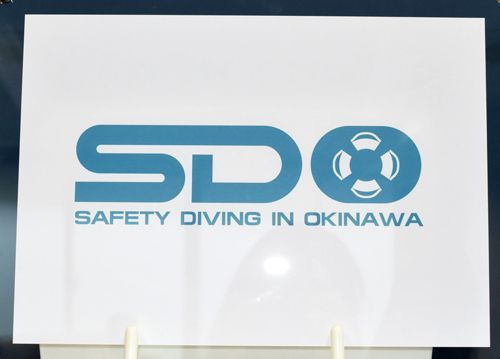
OMSB certification mark
OMSB holds seminars once a year to train industry personnel in methods to handle accidents, and certify participating industry personnel and guides as safe and trusted. It awards a certification mark according to ability, and serves as a guide to help customers make selections.
On January 11 at a press conference in Naha City, Ishimine, a representative director of OMSB, emphasized the significance of visually representing business quality, saying that it will “lead to industry development in Okinawa.”
President Taira of OCVB said, “Systems which aim to maintain the level of guides are rare in the world.”
(English translation by T&CT and Megumi Chibana)
Go To Japanese
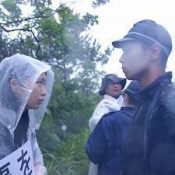
January 11, 2018 Ryukyu Shimpo
The 91st Kinema Jumpo top ten ranking for movies released in 2017 was announced January 10. “Target Island Kaji kataka,” the movie that deals with issues of military bases and the deployment of self defence forces on neighboring islands such as Miyako and Ishigaki, was ranked second in the cultural movie category. The movie was directed by Chie Mikami.
A film titled “Kamejiro, the man the U.S. military was most afraid of” ranked seventh in the same category. The movie is about politician Kamejiro Senaga and was directed by Tadahiko Sako.
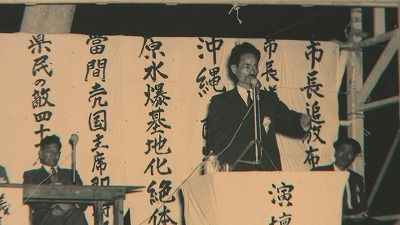
A scene from the “Kamejiro, the man the U.S. military was most afraid of”
The top spot in the cultural movie category was awarded to “Jinsei fruits” by Kenshi Fushihara.
“Yozora wa itsudemo saiko mitsudo no aoiro da,” translated as “The Tokyo Night Sky is Always the Densest Shade of Blue” by Yuya Ishii and “I, Daniel Blake” by Ken Loach received first place in the Japanese film category and the foreign film categoy respectively.
(English translation by T&CT and Sayaka Sakuma)
Go To Japanese
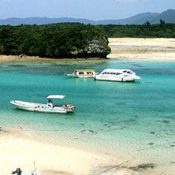
January 14, 2018 Ryukyu Shimpo
TripAdvisor, the world’s largest travel site, selected Ishigaki Island, Okinawa, number one on its “2018 Top Destinations on the Rise” list announced January 13.
User reviews highlighted coastal landscape that features “picturesque scenery” that is “like a magazine.” Favorite locations include Kabira Bay and the Cape Hirakubozaki Lighthouse. There are also reviews ocean activities and hotels in the city. According to the website, posts from foreign visitors to Kabira Bay and Yonehara Beach have been increasing.
The second spot on the list went to Kapaa, Hawaii, 3rd was Nairobi, Kenya, 4th was Halifax, Nova Scotia, and 5th was Gdansk, Poland.
Site ranking was based on the posts from travelers who use the site, with a focus on places that saw the biggest uptick in activity compared to the previous year. Travel destinations on the site were tracked from October 2016 to October 2017.
(English translation by T&CT and Sam Grieb)
Go To Japanese
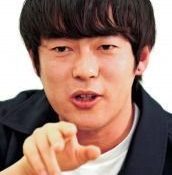
January 4, 2018 Ryukyu Shimpo
After drawing a lot of attention for a comedy routine on “The Manzai 2017,” a nationally televised comedy program on Fuji Television, that featured jokes and a satirization of base construction in Okinawa in places such as Henoko in Nago City and in Takae in Higashimura, Daisuke Muramoto from the comedic duo “Woman Rush Hour” held a press even for Okinawan news agencies while on tour in Naha.
Muramoto said, “I am neither supportive or opposed to the bases,” but added “If there are people upset by the issue, whether they are in favor of or against the bases, if we are all the same Japan I think we should be able to ask, ‘What’s the matter,’ and , ‘tell me more about it.’”
Muramoto came up with the idea to write jokes about the base issue after an exchange with journalist Jun Hori while appearing on his internet video series.
Based on the advice of Hori, Muramoto debuted his first joke about the bases around one year ago while performing at a theater in Naha, which was met with thunderous applause.
“It is a delicate issue. I apologize if it offends anyone,” said Muramoto. “I was surprised. People were telling me ‘Thank you’ with tears in their eyes. I was very happy to bring people that much joy.”
He promised to tell the joke on-air to a national audience, and later that year delivered.
This time, when visiting Okinawa for the live performances, Muramoto visited Henoko the evening of January 1, and listened to the thoughts of Okinawans engaged in a sit-in opposing the base construction over drinks.
“I better understand the burden from everyone’s thoughts.”
As for the online abuse towards the anti-base movement, Muramoto stresses, “There is something to [Okinawa’s] actions.
Have a drink and a conversation with them.
Then you can understand where they are coming from. If we can’t understand fellow Japanese, there is no way we will begin to understand China, North Korea, or the U.S. I think we need to understand one another first.”
(English translation by T&CT and Sam Grieb)
Go to Japanese
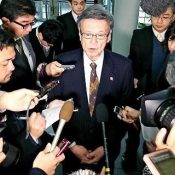
January 9, 2018 Ryukyu Shimpo
On the morning of January 9 Governor Takeshi Onaga gave his response to the recent consecutive emergency landings of U.S. Marine Corps helicopters on Ikeijima and in Yomitan Village.
He said, “I am truly at a loss for words. I feel immense resentment once again as [the Japanese government] uses the phrases ‘burden reduction’ and ‘constitutional nation’ to push forward at its discretion.”
In addition, he expressed his intention to keep requesting the suspension of flights of all types U.S. military aircraft stationed in Okinawa.
He gave his responses to a group of reporters at the Prefectural Office.
Alluding to the structural issues that allow the U.S. and Japanese governments to ignore Okinawans’ concerns, Onaga also mentioned, “These matters are throwing Japan’s democracy and regional autonomy into question.
It isn’t simply an issue of a few emergency landings.”
When asked about the substance of his upcoming requests, Onaga said, “That is a matter for after I make this request for [suspension of] all aircraft flights.
[The Japanese government] cannot even address one single request, so with its lack of jurisdiction, how can I expect further requests to fare?”
Also on January 9 Vice Governor of Okinawa Moritake Tomikawa called Ambassador in charge of Okinawan Affairs Tsukasa Kawada and Director-General of the Okinawa Defense Bureau Koichiro Nakajima to the Prefectural Office in order to make an objection regarding the problem of U.S. military helicopter emergency landings in Okinawa.
Tomikawa made plans to travel to Tokyo the next day and make a direct objection to the Japanese government.
Tomikawa responded to the press on his way to work on January 9, saying, “I am astonished to the point that I must express it. This is an abnormal situation among abnormal circumstances.”
Furthermore he said, “There have been no responses to the requests that all equipment undergo safety checks and that a conference concerning Okinawa be convened. If Okinawans do not push hard for their requests, they will not be able to live peacefully.”
(English translation by T&CT and Erin Jones)
Go to Japanese
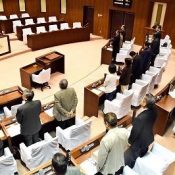
At 10:00 a.m. on January 11,
Uruma City Council President Seizen Ohya held an emergency meeting.
In this meeting, the city council unanimously came to a decision and created a memorandum regarding the forced landing of an U.S. military aircraft that took place at Ikei Island of Yonashiro Town.
People called for the suspension of flights by all aircraft types stationed at the U.S. military Futenma Air Station, suspension of all flights in which the aircraft flies over residential areas, and the downsizing of the in-Okinawa U.S. Marine Corps.
Uruma City Council Military Base Affairs Committee Chairman Tsutomu Kyan criticized the series of U.S. military aircraft accidents.
He read a document that said, “This exposes the lack of awareness by the U.S. military authorities regarding safety management, making us feel extreme indignation.”
The Uruma City Council visited the Okinawan Defense Bureau (ODB) with Ikei Residents’ Association Chairman Masanori Tamaki at 3:00 p.m. to make a decision on the protest and delivered the memorandum.
(English translation by T&CT and Chelsea Ashimine)
Go to Japanese
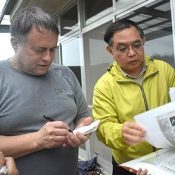
January 9, 2018 Ryukyu Shimpo
On January 8, Doug Bandow, Senior Fellow at the Cato Institute, a leading U.S. conservative think tank, visited Okinawa International University and Midorigaoka Nursery School in Ginowan, where he observed the situation of the U.S. base burden in Okinawa. Bandow, asked by parents at the nursery school for advice on how to achieve a halt to flights by U.S. military aircraft, said that if the Japanese prime minister tells the U.S. government to move the Marines, the U.S. government will have no choice but to act.
He added that if many Japanese citizens get involved, Prime Minister Shinzo Abe will be forced to convey the demand to the U.S. government.
Regarding the unceasing problems involving U.S. military aircraft, Bandow said that such problems occur not only in Okinawa, but anywhere that bases are located.
He said that with regard to Okinawa, the bases are simply too close to people’s daily lives.
At Okinawa International University, Bandow engaged in discussion with Professor Manabu Sato.
At Midorigaoka Nursery School, where a cylindrical object appearing to be from a U.S. military aircraft fell from the sky in December of last year, nursery school principal Takehiro Kamiya and parents of the children there told Bandow about what happened at the time the object fell.
After observing these sites, Bandow commented that aircraft were constantly flying overhead, saying that this is very unsuitable for the children’s growth and creates a poor environment for local residents.
(English translation by T&CT and Sandi Aritza)
Go to Japanese
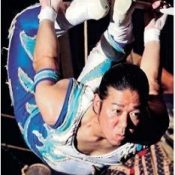
January 5, 2018 Ryukyu Shimpo
By Chikako Maemori
A skilled performer set the stage for a variety of performances; the 40-year-old performer from Ishigaki City, Kazuya Shimoji, performs three roles on his own at the Kinoshita Circus held at Toyosaki Town special venue in Tomigusuku City. He does aerial swings, the classical performance “One Ladder,” a motorbike show, and more. There are performances that only Shimoji can do. He is indispensable in the circus.
“Flyer from Ishigaki City, Kazuya Shimoji.” At the performance in Okinawa on December 29, this announcement was made at the end of the aerial swing. Following his swing, finger whistling and applause got louder and louder. Shimoji smiled and said, “It’s embarrassing, but I am happy that the venue gets excited.”
When Shimoji was a teenager and looking for a job in Nagoya, he watched the Kinoshita Circus and became captivated by it. Immediately after the performance, he called them to join. He got an interview the next day and started working after a week.
In the beginning Shimoji was not good at exercising. He was in a chemistry club at the junior high school. When he joined the circus, he could do pull-ups only three times. He practiced two to three hours every day after the performance to be able to perform on the stage. He began as a ticket attendant. After one year, he made his debut performing an aerial swing. He reflected, “Practice was not a hardship because I had comrades.”
For “One Ladder,” one person lies down, supporting a ladder with both feet, and a female performer goes up the ladder. The role of “Geso,” who supports the ladder, is hard to master because it requires patience and strength. Currently, only Shimoji can take the role. Eiichiro Nakazono, who has known Shimoji since the beginning of his career, says, “Shimoji is the type that fulfills his role diligently.”
This was the fourth day of performances in Okinawa. On the fifth day, Shimoji plays a classic performance “Kuzu no ha” for the first time in five and half years. Shimoji said, “I execute every single performance carefully. I hope Okinawan people know that there are people from Okinawa working hard in the performance.
(English translation by T&CT and Megumi Chibana)
Go to Japanese
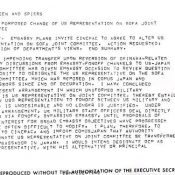
January 3, 2018 Ryukyu Shimpo
By Washington Special Correspondent Yukiyo Zaha and Ryota Shimabukuro
It recently came to light through declassified official U.S. documents that in May 1972, with the reversion of Okinawa to Japanese sovereignty posing a turning point, the U.S. Embassy in Japan proposed a review of the framework of the U.S.-Japan Joint Committee.
The Embassy was concerned about the existence of this unusual relationship built to function during the occupation period. This Joint Committee is a mechanism for discussion of U.S. military stationing in Japan established through the U.S.-Japan Status of Forces Agreement (SOFA).
The Department of State supported the Embassy’s proposal, but met with resistance from the U.S. military. So, the framework wherein military authorities headed the U.S. representation of the Committee was retained.
The Embassy’s proposal asked for changes to the framework in which the Deputy Commander of the U.S. Forces, Japan (USFJ) acts as representative of the Committee.
Because civilians account for all Japanese representation on the Committee, the proposal also suggested that U.S. representation be switched to Embassy diplomats, and that the U.S. military assist the Embassy from a technical perspective.
For the first time on the Joint Committee, currently five of the six U.S. committee representatives are military personnel.
Although it has been pointed out that military concerns take top priority in consultations between the U.S. and Japan, now criticism that the U.S. government’s inner operations are military-led is on the rise as well.
A July 31, 2002 command policy by the USFJ specified that, “The U.S. Representative [the Deputy Commander of the USFJ] is not solely a representative of U.S. Forces, Department of Defense, Army, Navy, Air Force and Marine Corps. He is a representative of the US Government.”
Furthermore it set out that, “The only person authorized to speak or to act for the U.S. in the Joint Committee is the U.S. Representative, or in his absence, the Senior or Alternate U.S. Deputy Representative.”
This policy demonstrates that even now the U.S. military holds great power on the Joint Committee.
In May 1972, U.S. Ambassador to Japan Robert Ingersoll sent a confidential telegram addressed to the Department of State expressing dissatisfaction with designation of Joint Committee U.S. representatives and proposing a review of this process.
It stated that discussions related to the reversion of Okinawa gave the Embassy occasion to review the question of the authority to designate U.S. representation on the SOFA Joint Committee.
It also pointed out that under the arrangement of the time, the U.S. military staff officials would deal directly with the Japanese government, bypassing the U.S. Embassy.
The Department of State replied in agreement to Ingersoll’s message, expressing that the Joint Committee framework is not consistent with arrangements in many other countries, and that considering the circumstances in Japan at the time this framework could no longer be justified.
However, the U.S. Pacific Fleet and USFJ resisted, arguing that it was important for the military to preserve its flexibility and responsiveness.
They also insisted that the Joint Committee functioned well, and there was no indication of Japanese officials requesting a change.
These arguments were sent to the U.S. Embassy in a telegram in June 1972.
In the same month the Embassy issued a document criticizing the Joint Committee framework and the unusual relationship built for the occupation period, in which Japanese civilian representatives directly discuss with U.S. military representatives.
In addition, since the security relationship with Japan has come to be affected by economic and political factors, the telegram contained a request for representative authority to be transferred to the U.S. Embassy.
However, an official document issued by the U.S. Embassy in August 1972 sets forth the series of events through which negotiations between the Embassy and the U.S. military ultimately concluded in a decision to modify operation internally on the U.S. side of the Committee, with the changes involving appointment of a diplomat from the Embassy as a representative agent, subordinate to the Deputy Commander of the USFJ, and timely provision by the U.S. military to the Embassy of information regarding politically sensitive issues.
The telegram from the U.S. Embassy in Japan is held in the National Archives.
(English translation by T&CT and Erin Jones)
Go to Japanese
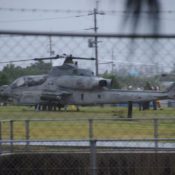
anuary 8, 2018 Ryukyu Shimpo online edition
On January 8 around 4:45 p.m. an AH-1 attack helicopter from MCAS Futenma made an emergency landing on the grounds of the Hijagawa administrative group waste disposal facility in Gima, Yomitan Village. People working in the fields nearby called the emergency number 110 to report the incident, and Kadena police officers responded and headed to the site. As of 6:30 p.m. (local time) on January 8, the helicopter had not taken off, and no information such as that relating to injuries had been released.
A ccording to the Okinawa Prefectural Police, the two crewmembers on the helicopter made an emergency landing due to the illumination of a warning light. The helicopter landed near the western coastline in Yomitan Village. About 500 meters east of the landing spot is a residential area, and south of the spot is Hotel Nikko Alivila.
ccording to the Okinawa Prefectural Police, the two crewmembers on the helicopter made an emergency landing due to the illumination of a warning light. The helicopter landed near the western coastline in Yomitan Village. About 500 meters east of the landing spot is a residential area, and south of the spot is Hotel Nikko Alivila.
(English translation by T&CT and Erin Jones)
Go to Japanese
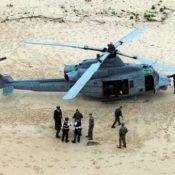
January 7, 2018 Ryukyu Shimpo
(Uruma, Ikei Island) A UH-1 U.S. military helicopter from MCAS Futenma made an emergency landing on a beach on the eastern side of Ikei Island in Uruma at around 4:00 p.m. on January 6. According to Okinawan police and the Okinawa Defense Bureau (ODB), no one was injured including the four passengers, and the helicopter had no visible damage.
In January of last year, there was also a helicopter from MCAS Futenma that made an emergency landing on Ikei, when an AH-1 attack helicopter landed on a farm road.
This past December, there were two incidents involving parts from a helicopter landing on a nursery school and an elementary school in Ginowan.
The Ikei city council held an emergency meeting on the evening of January 6, and made a plan to hold a rally in January protesting the frequent incidents caused by the U.S. military.
The helicopter landed only 100 meters from houses.
About 13 km. to the southwest is Naval Base White Beach, and a petroleum station is about 5 km. away from the site of the landing.
According to Uruma’s Central Fire Department, who first reported the emergency landing, the helicopter had just finished training exercises at the Ukibaru Island Training Ground.
According to the ODB, the helicopter landed on Ikei Island after a warning light came on.
The military explained that the helicopter made a “preventative landing,” in order to prevent an accident, and plans to come retrieve the vehicle as early as January 7.
On January 6, U.S. military personnel performed a safety inspection, and the Japanese Coast Guard installed an oil fence to prevent fuel from leaking into the water.
According to Okinawa Base Policy Division chief Norikazu Kinjo, a munitions check was not done.
The Okinawan Prefectural government received word from the ODB at 5:30 p.m. Then, just after 7:00, Lieutenant General Lawrence Nicholson, commanding general of U.S. forces in Okinawa, informed Okinawan Deputy Governor Moritake Tomikawa that, “The helicopter made an emergency landing after an abnormal reading from one of the instruments.”
That evening, Governor Takeshi Onaga made known his misgivings at a press conference in Naha, saying that “It’s a ridiculous story.”
The prefectural government will call senior officials from both the Ministry of Foreign Affairs’ (MOFA) Okinawan office and the ODB to protest at the beginning of the week.
Masanori Tamagusuku, 61, president of the Ikei city council, said indignantly, “This is the current reality of Okinawa. The U.S. military does whatever it wants. If the federal Japanese government does not assert their independence when working with the U.S. military, it will eventually be the people of Okinawa who suffer.”
(English translation by T&CT and Sam Grieb)
Go to Japanese












 ccording to the Okinawa Prefectural Police, the two crewmembers on the helicopter made an emergency landing due to the illumination of a warning light. The helicopter landed near the western coastline in Yomitan Village. About 500 meters east of the landing spot is a residential area, and south of the spot is Hotel Nikko Alivila.
ccording to the Okinawa Prefectural Police, the two crewmembers on the helicopter made an emergency landing due to the illumination of a warning light. The helicopter landed near the western coastline in Yomitan Village. About 500 meters east of the landing spot is a residential area, and south of the spot is Hotel Nikko Alivila.
 Webcam(Kokusai Street)
Webcam(Kokusai Street)


